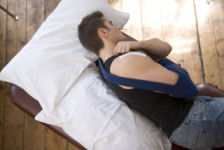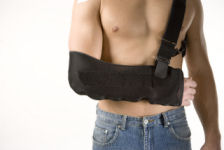Arthroscopic Stabilisation (Bankart Repair)
This procedure involves repairing the over stretched or torn labrum and capsule deep within the shoulder joint. We prefer to perform the surgery arthroscopically (keyhole), but some surgeons prefer an open procedure. The doctors will discuss your individual surgery with you before the operation.
Your Operation
You must not eat or drink anything after midnight the day before your surgery. When you wake up following the procedure you will be wearing a sling with a body belt. This may be a standard sling or an External Rotation sling, depending on the procedure performed (see pictures below). The sling should be worn at night and when out and about for 3 weeks. You will then wean off the sling with the aid of your physiotherapist over the next 3 weeks.
For more details on Living with a Shoulder Sling CLICK HERE
You should be able to go home the same day as your operation, but may be in hospital overnight. A physiotherapist will see you in hospital to teach you the appropriate exercises. You may also see an occupational therapist to give you advice regarding the use of your arm.
PAIN
A nerve block is usually used during the surgery. This means that immediately after the operation the shoulder and arm often feel completely numb. This may last for a few hours. After this the shoulder may well be sore and you will be given painkillers to help this whilst in hospital. These can be continued after you are discharged home. Ice packs may also help reduce pain. Wrap crushed ice or frozen peas in a damp, cold cloth and place on the shoulder for up to 15 minutes. Ensuring you cover the wound site with a piece of cling film to keep the area dry.
THE WOUND
Open repair: There is an incision at the front of the armpit within the natural skin crease. The stitch is dissolvable but is usually removed at 3 weeks. Keep the wound dry until it is well healed. This usually takes 3 weeks.
Arthroscopic (keyhole) repair: This keyhole operation is usually done through two or three 5mm puncture wounds. There will be no stitches only small sticking plaster strips over the wounds. These should be kept dry until healed. This usually takes 5 to 7 days.
SLEEPING
For the first three weeks your sling must be worn in bed. Sleeping can be uncomfortable if you try and lie on the operated arm. We recommend that you lie on your back or on the opposite side, as you prefer. Ordinary pillows can be used to give you comfort and support. If you are lying on your side one pillow slightly folded under your neck gives enough support for most people. A pillow folded in half supports the arm in front and a pillow tucked along your back helps to prevent you rolling onto the operated shoulder during the night. If you are lying on your back, tie a pillow tightly in the middle (a "butterfly pillow") or use a folded pillow to support your neck. Place a folded pillow under the elbow of the operated arm to support that.


FOLLOW UP APPOINTMENTS
An appointment will be made for you to see the surgeon or specialist therapist 3 weeks post-operatively.
DAILY ACTIVITIES
For the first three weeks most activities of daily living for example feeding, dressing, cooking etc must be carried out using your un-operated arm. If appropriate an occupational therapist will be available to give you advice on how to do this.
LEISURE ACTIVITIES
Your physiotherapist and surgeon will advise you when it is safe to resume your leisure activities. This will vary according to your sport and level, as well as the period required to retrain your shoulder muscles with physiotherapy.
Below is a rough guide:
| Swimming | Breastroke Freestyle |
6 weeks 3 months |
| Golf | 3 months | |
| Contact Sport | Includes rugby, horse riding, football, martial arts, racquet sports, and rock climbing | 3 months |
DRIVING
You will not be able to drive for a minimum of 6 weeks. Your surgeon will confirm when you may begin.
RETURNING TO WORK
This will depend upon the size of your tear and your occupation. You will need to discuss this with your surgeon.
REHABILITATION PROTOCOL
The physiotherapy rehabilitation protocol will vary according to the type of stabilisation performed:



